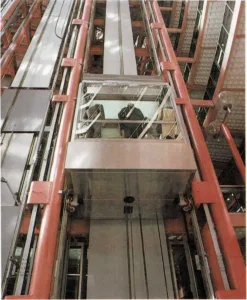
An elevator car hangs on steel cables inside a shaft. A pulley turns
the cables to make the car slide up or down.
An up-down machine
Climbing the stairs in a house is easy. But in a tall building with many
floors, it’s hard work! People need a better way to get up to the top
floors and then down again. This \”better way” is an elevator.
An elevator is really a lifting machine. In England and some other
countries, that’s what it’s called—a lift. The invention of the
elevator has made it possible for people to build and use skyscrapers.
The elevator is like a small room that can be raised and lowered. Strong
steel ropes, called cables [(kay]{.smallcaps} buhlz), pull the car up
and lower it down. And steel tracks, or guide rails, keep the car from
swinging sideways.
The cables are attached to the top and bottom of the elevator car. Then
they are wound around large pulleys at the top and bottom of the
building to make a strong, tight loop.
The car hangs on one side of the loop. On the other side, the cables are
connected to a heavy weight. The hanging weight pulls against the weight
of the car. This makes it easier to move the car.
When someone presses the elevator button, an electric signal is sent to
a motor at the top of the shaft. The motor turns the top pulley and
makes the cables move.
If the pulley is turned one way, the weight is lowered and the car moves
up. If it is turned the other way, the weight is raised and the car
moves down. The pulley keeps turning and the cables keep moving until
the car reaches the right floor. Then the motor stops, and the car doors
open so that people can get on or off the elevator.

